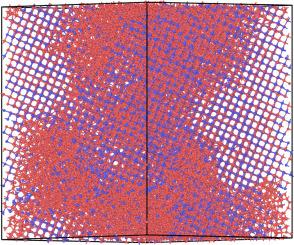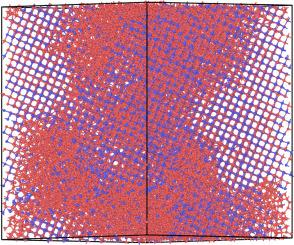基于机器学习原子间势的大规模模拟富锗锗合金的结晶动力学
IF 9.3
1区 材料科学
Q1 MATERIALS SCIENCE, MULTIDISCIPLINARY
引用次数: 0
摘要
富锗geexxte合金的机器学习原子间势已经被开发出来,旨在揭示这些材料的相分离和结晶动力学。这些结果对利用GeSbTe合金富锗来提高结晶温度的嵌入式相变存储器的操作具有重要意义。势能是通过将密度泛函理论中计算的大型能量和力数据库与DeePMD-kit包中实现的神经网络方案拟合而产生的。该势非常精确,适合描述从纯锗和化学计量锗到富锗锗合金的各种成分的液态、非晶和结晶相的结构和动力学性质。大尺度分子动力学模拟表明结晶机制依赖于温度。在600 K时,观察到大部分过量锗的偏析发生在ns时间尺度上,然后是接近化学计量量的GeTe区域结晶。在500 K时,观察到结晶GeTe的成核发生在相分离之前,随后由于同时排出过量的Ge而缓慢生长。本文章由计算机程序翻译,如有差异,请以英文原文为准。


Crystallization kinetics in Ge-rich GexTe alloys from large scale simulations with a machine-learned interatomic potential
A machine-learned interatomic potential for Ge-rich GeTe alloys has been developed aiming at uncovering the kinetics of phase separation and crystallization in these materials. The results are of interest for the operation of embedded phase change memories which exploits Ge-enrichment of GeSbTe alloys to raise the crystallization temperature. The potential is generated by fitting a large database of energies and forces computed within Density Functional Theory with the neural network scheme implemented in the DeePMD-kit package. The potential is highly accurate and suitable to describe the structural and dynamical properties of the liquid, amorphous and crystalline phases of the wide range of compositions from pure Ge and stoichiometric GeTe to the Ge-rich GeTe alloy. Large scale molecular dynamics simulations have suggested a crystallization mechanism which depends on temperature. At 600 K, segregation of most of Ge in excess was observed to occur on the ns time scale followed by crystallization of nearly stoichiometric GeTe regions. At 500 K, nucleation of crystalline GeTe was observed to occur before phase separation, followed by a slow crystal growth due to the concurrent expulsion of Ge in excess.
求助全文
通过发布文献求助,成功后即可免费获取论文全文。
去求助
来源期刊

Acta Materialia
工程技术-材料科学:综合
CiteScore
16.10
自引率
8.50%
发文量
801
审稿时长
53 days
期刊介绍:
Acta Materialia serves as a platform for publishing full-length, original papers and commissioned overviews that contribute to a profound understanding of the correlation between the processing, structure, and properties of inorganic materials. The journal seeks papers with high impact potential or those that significantly propel the field forward. The scope includes the atomic and molecular arrangements, chemical and electronic structures, and microstructure of materials, focusing on their mechanical or functional behavior across all length scales, including nanostructures.
 求助内容:
求助内容: 应助结果提醒方式:
应助结果提醒方式:


